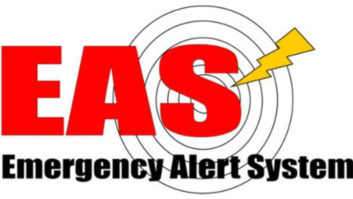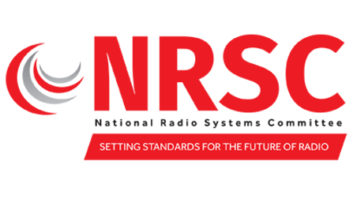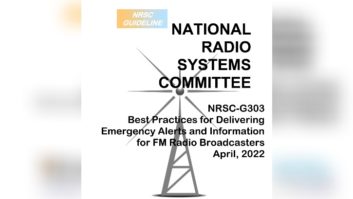A big thumbs up, so far.
Initial reports rolling in from radio people across the United States suggest that the third national test of the Emergency Alert System has gone off without much trouble, though there were notes here and there of hissy audio, and some initial trouble logging into the FCC’s online reporting system.
The National Periodic Test was sent by the Federal Emergency Management Agency at 2:20 pm Eastern time on Sept. 27 with resource links to audio files in English and Spanish. According to one EAS equipment manufacturer who watched the test origination via webinar, the NPT alert was originated and sent right at 2:20 using a Digital Alert Systems DASEOC unit located at the National Emergency Management Association conference in Scottsdale, Ariz.
Officially, the NPT posted on IPAWS OPEN as a CAP message at 12:20:24 Eastern. The CAP message was sent with the two languages along with resource links to the audio messages for each language.
“This was the first time FEMA initiated an NPT alert while ‘on the road’ since doing their regional NPT testing some time ago. Origination appeared to have went perfectly,” said Ed Czarnecki, senior director of strategic and global government operations for Monroe Electronics.
A quick roundup check suggests things went smoothly.
“Things worked well in this part of Texas,” said Ben Downs, general manager of Bryan Broadcasting, which operations radio stations in Texas. “We have three sets of receivers and we heard the message clearly on all three.”
Exceptions are not unheard of on a national test, he continued. “We had one receiver that received three sets of alert tones; one right after the other. The message wasn’t repeated however.”
He also noted that his stations received the alert via the EAS system from an LP2 monitor station. The CAP message arrived two minutes later.
For Gary Timm, broadcast chair of the Wisconsin State Emergency Communications Committee, the EAS audio message was clear and strong on the stations that he monitored.
The same was true for some in the Golden State. “For us, it could not have gone better,” said Paul Sakrison, operations manager and chief engineer for the Los Angeles Angels Radio Network. “It went perfectly. The activation came from IPAWS directly. The audio message was from the embedded link and it was high quality with no artifacts. The message was short and efficient. The EOM was tight.
“We’re very happy with this test at KLAA(AM),” he said.

Here is a screenshot of the info that the Sage EAS boxes at Bryan Broadcasting received. The first shows the station sending the alert it already received; the second shows the reception of a duplicate copy of the alert via CAP..
The NPT was a success in Nevada, said Adrienne Abbott, the state EAS chair for the Nevada Broadcasters Association.
“So far, the Nevada stations are reporting that the NPT was received and relayed successfully,” she said. “A few stations in the more rural areas report that their audio was ‘noisy’ but the message was still usable. The stations in more remote areas where there are no other broadcast signals received the NPT from the IPAWS CAP Aggregator and relayed it successfully.”
Abbott did note that the DirecTV audio in Nevada was poor quality, which has been noted by others as well, she said.
Back east in Luzerne County, Pa., the test seemed to go smoothly, though there were some issues with audio quality. Bob Reite, chief engineer at WHLM(AM), said that this year in Columbia County, as last year, the station did not get the CAP message, but instead received the test from its LP-1 station.
“Like last year it was hissy, as if the LP-1 had received it from a PEP station rather than IPAWS/CAP,” he said. There were a few other hiccups. A report from WISC(TV) in Madison, Wis., noted a cable box lock-up issue, a source said. Apparently after some of the cable tuners went to the EAS channel to display the text of the message, the box did not return viewers to the previously tuned channel as it was supposed to do. Viewers saw a black screen with no audio. Nearly 10 minutes after the test, the Charter cables for at least one viewer were still black and silent.
After the test, broadcasters had a quick turn-around-job: file Form Two with the Federal Communications Commission in the ETRS database to note whether or not the test came in to their individual station. Stations have until 11:59 PM Eastern on Sept. 27 to file Form Two. There were mixed comments on the process of logging into the FCC’s ETRS database. Sakrison noted that he had successfully completed both Form Two and Form Three, the latter of which offers more detailed information on the Sept. 27 test. Happily, he did not run into any ETRS site access problems, he said.
“The site was quick and efficient,” he said. “I received confirmation emails from the FCC.”
Others hit some initial snags. “I did have some issues with logging in,” Downs said. “Apparently when the site gets really busy, it dumps you into the administration portion of the site.
But he was able to get in eventually, and had finalized Form Two for his nine stations less than three hours after the test was complete.
The technology behind the scenes seemed to work as expected, said Czarnecki. “We’re in the process of hearing back from broadcast and cable operators on how they fared with the alert,” he said, noting that some DASDEC users have indicated that they received the NPT alert almost as soon as IPAWS posted it, and transmitted the test alert with excellent first-generation audio from the CAP messages.
Others have indicated receiving the alert from an upstream broadcast EAS source, so the audio quality was reported to have suffered a bit in the EAS relay compared to CAP, Czarnecki said.
The few audio issues he’d heard about appear to be related to the upstream source, not the equipment at the station, he said.“As with last year’s test, we’ll be eager to see the FCC and FEMA reporting on the test results, including the portion of stations that processed the CAP message versus the EAS relay message,” he said.
Share your own observations about the test at your end. Email [email protected].












